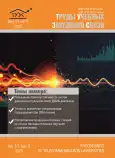Relevance. Currently in Russia and in the world there is an active transition from analog to digital technologies. This process is also fully applicable to radio broadcasting. In Russia, experimental digital radio broadcasting (DRB) is authorized in the VHF band in three formats: DRM, DAB, and RAVIS. However, the Government has not yet decided to choose one of these formats as the national standard, which is explained primarily by the insufficient completeness of the information required for the production and operation of equipment related primarily to the DRM system, the only DRB system recommended by ITU-R for being used in all frequency bands allocated for terrestrial radio broadcasting. This paper fills this gap as it relates to the development of receiving equipment. Purpose of this work: estimation of the required accuracy of the start moment of the direct discrete Fourier transform with respect to the beginning of the useful part of the OFDM symbols, where the error signal for the DRM system, while operating in the E stability mode, does not exceed the values required by the ITU-R standard and recommendation BS.1660-8 (06/2019).Methods. As a basis to execute this research, the simulation model of the DRM system transceiver path for the stability mode E, was chosen. It is supplemented with modules that allow, for different types of modulation and protection levels, to change the time shift in the receiver between the start of the direct discrete Fourier transform and the beginning of the useful part of the OFDM-symbol, as well as to evaluate, at each value of the time shift, quality of the signal received by the DRM-receiver. Results. The modulation error rate (MER) and bit error rate (BER) were chosen as the criteria for evaluating the quality of the received OFDM signal. It is shown that, in order to maintain conditions of a comfortable reception, the maximum allowable time mismatch between the start of the direct discrete Fourier transform and the beginning of the useful part of the OFDM-symbol, at modulation of subcarrier frequencies QAM-4, should not exceed 1,8 - 2,3 μs; at modulation QAM-16 this value should not exceed 0,8-1,3 μs. The range of values obtained is determined by the protection level PL. The main impact on the required accuracy of time synchronization of a DRM-receiver, while operating in the stability mode E, has the order of modulation QAM; significantly less influence has the level of protection PL if the probability of bit errors does not exceed 10-4. For BER≤10-4, the influence of the chosen level of protection PL can be neglected. The obtained results are new for the DRM system while operating in the E stability mode (VHF band).Theoretical / Practical significance. The method of estimation of the acceptable time mismatch of OFDM-signal at DRM-reception is proposed. The results are necessary for the development of the time synchronization unit of digital radio broadcasting DRM-receivers.
 7-19
7-19


 20-31
20-31


 32-40
32-40


 41-48
41-48


 49-55
49-55


 56-66
56-66


 67-82
67-82


 84-100
84-100


 101-108
101-108


 109-120
109-120







